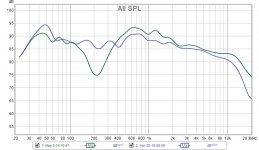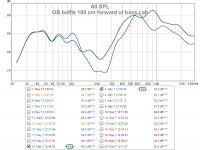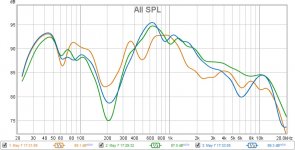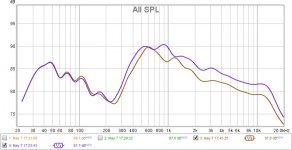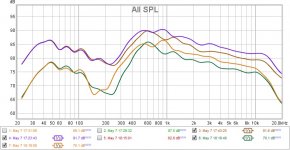@ Mike56, take a look at Siegfried Linkwitz's site, Linkwitz Lab - Loudspeaker Design. His LX5 (?) speakers are dipoles, powered by five amplifiers and MiniDSP EQ/crossover. His is THE BEST home stereo system I've ever heard, and that's saying a lot.
Thankfully, a good friend of his, whose name I can't think of at the moment, is maintaining Siefried's site, so it's still there.
Thankfully, a good friend of his, whose name I can't think of at the moment, is maintaining Siefried's site, so it's still there.
You are probably losing some midbass which would effect that. I see a measuring mic, can you post some measurements?I have been listening a while now and all sorts of percussion is more apparent than it was, it definitely has some appealing aspects.
@ Mike56, take a look at Siegfried Linkwitz's site, Linkwitz Lab - Loudspeaker Design. His LX5 (?) speakers are dipoles, powered by five amplifiers and MiniDSP EQ/crossover. His is THE BEST home stereo system I've ever heard, and that's saying a lot.
Thankfully, a good friend of his, whose name I can't think of at the moment, is maintaining Siefried's site, so it's still there.
Many thanks, i have read a lot about him and on his site, it is probably one of the reasons i started on this route. I had recently completed build of Troels Gravesen designed Fusion Bad and they are very nice, i was just seeking, whilst in lockdown, to experiment with what OB sounds like, so i have taken the components i have and put the mid and treble OB, it might encourage me to go further sometime, but i am mostly passive with a tube amp doing the initial work and Hypex DSP on the bass from its high level input, so the OB experiment is exactly like that
You are probably losing some midbass which would effect that. I see a measuring mic, can you post some measurements?
It absolutely amazes me how you guys know all this stuff, and can predict such things, i did do some measurements and there is a big hole in the x over region around 200Hz, i didn't save those, but here is a quick comparison just now, the OB in green, compared with a similar position where i had the Fusions, i can flatten that bass hump on the Fusions, but they are way up the room to achieve it, it sounds better but is not practical
Attachments
"It absolutely amazes me..."
I don't know about other posters, but I studied this stuff in college when I was a music major, and worked in audio and acoustics for many years. Frankly, having a basic understanding of loudspeakers, musical instruments, and room acoustics is within the reach of any thinking person. The problem, in many cases, is that people only read hi-fi magazines and listen to hi-fi salesmen. They should expand their knowledge base to include the professional folks who've been studying this stuff for decades.
🙂
I don't know about other posters, but I studied this stuff in college when I was a music major, and worked in audio and acoustics for many years. Frankly, having a basic understanding of loudspeakers, musical instruments, and room acoustics is within the reach of any thinking person. The problem, in many cases, is that people only read hi-fi magazines and listen to hi-fi salesmen. They should expand their knowledge base to include the professional folks who've been studying this stuff for decades.
🙂
It's the slope below the dipole peak and relates to baffle size. Electro-acoustic models You may be able to mitigate the hole a little by running the mid fullrange.
"It absolutely amazes me..."
They should expand their knowledge base to include the professional folks who've been studying this stuff for decades.
🙂
Credit to all those who have that basic understanding! - seems to me it's actually many subjects with numerous different areas to understand, i thought i had done quite well to build a decent pair of speakers that someone else designed! - and here, despite some reading and thinking i am well out my depth - maybe that's part of the fun....
It's the slope below the dipole peak and relates to baffle size. Electro-acoustic models You may be able to mitigate the hole a little by running the mid fullrange.
I think i understand the slope point, no idea how to set about running the mid full range, i assume so that it starts to slope off lower down? - i wondered about using the bass driver to try and fill the gap as i have the programmable Hypex on that, except i don't understand it well enough to try that. However i could read up on it........
Of course it would be fun to continue and see what else i might experience but....
It may now be the point to put this experiment to one side, reassemble my very nice Fusions and decide if i might make a purpose designed pair of something OB........but i already know that stopping here would be disapointing.
I think i understand the slope point, no idea how to set about running the mid full range, i assume so that it starts to slope off lower down? - i wondered about using the bass driver to try and fill the gap as i have the programmable Hypex on that, except i don't understand it well enough to try that. .
Any of you kind folk have some time and inclination to help me more please, the sound is interesting enough to spend a little more time, if using the bass driver up to 300Hz will fill that hole in FR, is there an idiot/dummy guide to programming the Hypex step by step to do that?
The dip in your response between mid and woofer could well be in part by the time alignment being off.
This page from linkwitz might be of some assistance
Woofer crossover & offset
A simple test is to move the woofer box forwards and backwards while measuring with pink noise using the RTA of REW set to average and see where you get the best summation. Or just take sweep measurement at different points and see the difference. Once you have established the offset needed you can add that as a delay in the DSP and put the speaker box where you want it to be and adjust the delay accordingly.
There is thread here on the Hypex Filter Design software somewhere and I assume a manual on their site which is where I would start 🙂
This page from linkwitz might be of some assistance
Woofer crossover & offset
A simple test is to move the woofer box forwards and backwards while measuring with pink noise using the RTA of REW set to average and see where you get the best summation. Or just take sweep measurement at different points and see the difference. Once you have established the offset needed you can add that as a delay in the DSP and put the speaker box where you want it to be and adjust the delay accordingly.
There is thread here on the Hypex Filter Design software somewhere and I assume a manual on their site which is where I would start 🙂
The dip in your response between mid and woofer could well be in part by the time alignment being off.
This page from linkwitz might be of some assistance
Woofer crossover & offset
A simple test is to move the woofer box forwards and backwards while measuring with pink noise using the RTA of REW set to average and see where you get the best summation. Or just take sweep measurement at different points and see the difference. Once you have established the offset needed you can add that as a delay in the DSP and put the speaker box where you want it to be and adjust the delay accordingly.
There is thread here on the Hypex Filter Design software somewhere and I assume a manual on their site which is where I would start 🙂
Many thanks Fluid for another interesting response, i scanned the Linkwitz page and he talks of moving woofers a distance up to 3' which surprises me, i shall have a play and report back. Reading Hypex will have to follow as that is dull for me, even in lockdown!
The dip in your response between mid and woofer could well be in part by the time alignment being off.
This page from linkwitz might be of some assistance
Woofer crossover & offset
A simple test is to move the woofer box forwards and backwards while measuring with pink noise using the RTA of REW set to average and see where you get the best summation. Or just take sweep measurement at different points and see the difference. Once you have established the offset needed you can add that as a delay in the DSP and put the speaker box where you want it to be and adjust the delay accordingly.
There is thread here on the Hypex Filter Design software somewhere and I assume a manual on their site which is where I would start 🙂
I did it in 5cm stages, using one side only, bass cab going further away first and there was gradual improvement, but this was also giving a gradual rise in bass response lower down so i went the other way and moved the OB forward of the bass, up to 100cm was still reducing the dip, by then its become impractical to actually position and live with though
Attachments
Connect it straight to the amplifier, ie, to the crossover input.I think i understand the slope point, no idea how to set about running the mid full range
Does it get unhappy trying to reproduce frequencies outside its range, or does it just not respond to them please, i don't want to cook it.........Connect it straight to the amplifier, ie, to the crossover input.
High frequency won't hurt it, be careful with low frequency excursion though, try it at low volume at first to see if the dip fills in at all.
I did it in 5cm stages, using one side only, bass cab going further away first and there was gradual improvement, but this was also giving a gradual rise in bass response lower down so i went the other way and moved the OB forward of the bass, up to 100cm was still reducing the dip, by then its become impractical to actually position and live with though
Mike,
Just for giggles, try inverting the phase of the woofer and repeating the exercise.
Also, change the position of the mic (higher / lower / closer to / further from the speaker) to see if the shape / depth of the dip changes. I often see a dip in that frequency range due to floor bounce cancellation when measuring in-room. You don't want to wind up chasing your tail over a measurement anomaly.
Thanks all, so a few things to experiment with before cooking dinner, different mic positions attached, yes it can change the depth of the ravine, but the trend is the same, good thought, the best "orange" trace would have been listening lying down height!Mike,
Just for giggles, try inverting the phase of the woofer and repeating the exercise.
Also, change the position of the mic (higher / lower / closer to / further from the speaker) to see if the shape / depth of the dip changes. I often see a dip in that frequency range due to floor bounce cancellation when measuring in-room. You don't want to wind up chasing your tail over a measurement anomaly.
Next some wiring.....
Attachments
Mike,
Just for giggles, try inverting the phase of the woofer and repeating the exercise.
Woofer out of phase = same as moving the baffles apart, was that expected?
Attachments
Running the mid range doesn't seem the route, here attached a comparison with the woofer out of phase and the baffles at 1m apart which produced the same improvement, the mid full range was not as good as either of those, whether in line or apart and that improvement has disappeared, its the slope?It's the slope below the dipole peak and relates to baffle size. Electro-acoustic models You may be able to mitigate the hole a little by running the mid fullrange.
Attachments
It can help to align the phase slopes in the same way as moving or time delay.Woofer out of phase = same as moving the baffles apart, was that expected?
Your measurements show there was some time delay mismatch but you are now left with a dipole peak and dipole roll off to correct for.
Measure the mid only on to see what the response is. Do the same for the woofer.
That will give you an idea of what is needed. Looking at the way the Fusion is setup I don't know if you will have much flexibility for EQ'ing the mid which is what is needed most.
Another simple thing that might help is to increase the woofer level.
- Home
- Loudspeakers
- Multi-Way
- Open baffle or box
